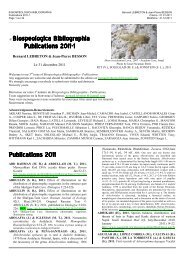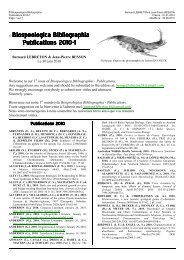Biospeologica Bibliographia Publications 2010-2
Biospeologica Bibliographia Publications 2010-2
Biospeologica Bibliographia Publications 2010-2
Create successful ePaper yourself
Turn your PDF publications into a flip-book with our unique Google optimized e-Paper software.
© <strong>Biospeologica</strong> <strong>Bibliographia</strong><br />
<strong>Publications</strong> <strong>2010</strong>-1<br />
Page 38 sur 116<br />
inhabiting ground waters of Slovenia depict a fauna of approximately 50<br />
species, 20 of which are stygobionts. In the last decades, new researches<br />
in Slovenian ground waters enabled us to study into more depth the<br />
oligochaete fauna of this environment. The studied material resulted from<br />
three main sources: a campaign in Slovenian caves conducted by Fabio<br />
STOCH, a large collection of groundwater fauna made available to us by<br />
Boris SKET, and samples collected during the European project<br />
PASCALIS. The data derived from the examination of this large amount<br />
of material enabled us to broaden the faunistic spectrum of oligochaetes<br />
of Slovenia, as well as to show that the oligochaete biodiversity in<br />
Slovenian ground waters is a substantial fraction of the European one.<br />
Endemic and very rare species constitute a remarkable proportion of the<br />
stygobiont oligochaete fauna. Among these, the genera Rhyacodriloides,<br />
Cernosvitoviella, Parvidrilus, Trichodrilus and Haber are some of the<br />
most outstanding taxa. In Pajsarjeva Cave, which was sampled many<br />
times over the past 15 years, the sporadic presence of some species, as<br />
well as the high rate of presence of stygobionts lead us to formulate a<br />
hypothesis about the relationship between the faunal data and the<br />
hydrogeology of the cave. http://www.icsb<strong>2010</strong>.net/<br />
GIBERT (J.), GEOFFROY (J.-J.) & MESSANA (G.),<br />
<strong>2010</strong>. Jacques MATHIEU, January 28 th 1942 - July 27 th<br />
2007. SIBIOS-ISSB Newsletter 7(2006-<strong>2010</strong>):37-42.<br />
GILLAM (E. H.), HRISTOVB (N. I.), KUNZ (T. H.) &<br />
McCRACKEN (G. F.), <strong>2010</strong>. Echolocation behavior of<br />
Brazilian free-tailed bats during dense emergence flights.<br />
Journal of Mammalogy 91(4):967-975. DOI:<br />
http://dx.doi.org/10.1644/09-MAMM-A-302.1. ABS:<br />
Brazilian free-tailed bats (Tadarida brasiliensis) emerge from cave roosts<br />
in dense columns in which adjacent bats are separated by only small<br />
distances. We describe and quantify variation in the structure of<br />
echolocation calls produced by these emerging bats and determine if call<br />
structure changes in relation to the rate of emergence measured using<br />
thermal infrared imaging. We recorded emergence calls at 2 roosts, 1<br />
housing approximately 200000 bats and the other approximately 17000<br />
bats. We found that Brazilian free-tailed bats emit distinct frequencymodulated<br />
(FMstart) and constant frequency (CFstart) calls during<br />
emergence that are significantly different from echolocation calls they<br />
emit while foraging. We propose that these calls provide different<br />
information for orientation within the emergence column. CFstart calls<br />
are very similar to social calls used by Brazilian free-tailed bats,<br />
suggesting 2 potential functions for this call type. The structure of both<br />
the FMstart and CFstart calls were not related to the number of bats<br />
emerging from a roost, although significant structural differences existed<br />
between sites. The differences between sites could be associated with the<br />
spacing of bats during emergence, because bats appeared to form tighter<br />
columns at the larger roost colony compared to the smaller colony. KW:<br />
Bats, echolocation, emergence, Tadarida.<br />
GINARD (A.), VICENS (D.), ROSSELLÓ (J. A.), PONS<br />
(G. X.), MIR-GUAL (M.), PLA (V.), CRESPÍ (D.),<br />
BARCELÓ (M. À.) & BOVER (P.), <strong>2010</strong>. Pteridòfits i<br />
briòfits de les cavitats de la serra de na Burguesa (Serra de<br />
Tramuntana, Mallorca). Endins 34:69-86. RES: Se citen els<br />
pteridòfits i els briòfits que s'han observat tant a les cavitats naturals com<br />
a les mines i pedreres de la serra de na Burguesa. En comparació amb la<br />
zona central de la serra de Tramuntana, no hi ha una flora briofítica i<br />
pteridofítica relictual, exceptuant Homalia lusitanica i Asplenium<br />
scolopendrium que s'han trobat a una única cavitat, el Clot des Sero.<br />
Asplenium sagittatum s'ha observat a 15 cavitats i en una d'aquestes ha<br />
desaparegut una població, per causes desconegudes, en un període d'uns<br />
sis anys. Anogramma leptophylla, Asplenium petrarchae i Asplenium<br />
trichomanes subsp. inexpectans és la primera vegada que se citen en<br />
aquesta serra. ABS: We have studied the pteridophytes and bryophytes<br />
observed in natural cavities as well as in mines and quarries of Na<br />
Burguesa mountain range. Compared with the central area of the<br />
Tramuntana mountains, it is not present a relictual bryophyte and<br />
pteridophyte flora, except Homalia lusitanica and Asplenium<br />
scolopendrium found at a single cavity, the Clot des Sero. Asplenium<br />
sagittatum was observed in 15 of these cavities and in one of them it was<br />
noticed its decline for unknown reasons, during the last six years.<br />
Anogramma leptophylla, Asplenium petrarchae and Asplenium<br />
trichomanes subsp. inexpectans are recorded for the first time in this area.<br />
GIRARD-CLAUDON (J.), <strong>2010</strong>. Évolutions récentes des<br />
populations de chiroptères en région Rhône-Alpes: essai<br />
Bernard LEBRETON & Jean-Pierre BESSON<br />
Créé le : 01.01.<strong>2010</strong><br />
Modifié le : 30.06.<strong>2010</strong><br />
de synthèse [Recent evolution of bat populations in Rhone-<br />
Alpes: a synthesis]. Bulletin mensuel de la Société<br />
linnéenne de Lyon, hors-série n° 2:? RÉS: Le groupe des<br />
chiroptères compte trente-quatre espèces en France. En raison de leurs<br />
mœurs nocturnes, ces mammifères n'ont été étudiés que tardivement. En<br />
effet, il n'y avait que peu de chiroptérologues dans la région jusqu'à la<br />
moitié du vingtième siècle. Au cours de la fin de ce siècle, le nombre de<br />
spécialistes a considérablement augmenté et les techniques d'études des<br />
chauves-souris se sont largement développées et diversifiées. Cet article<br />
est un essai de synthèse sur l'évolution des populations de chauves-souris<br />
en Rhône-Alpes. Nous pouvons distinguer deux périodes différentes: - Au<br />
cours des années 1950-1960, les populations de chauves-souris se sont<br />
effondrées en France, probablement en raison des activités humaines<br />
(modification dans les pratiques agricoles, urbanisation, transport,<br />
tourisme souterrain, etc.). - Au cours de la fin du vingtième siècle des<br />
suivis ont été mis en place progressivement par les chiroptérologues.<br />
Malgré le peu de recul, des tendances d'évolutions semblent se dégager.<br />
Ainsi nous pouvons par exemple dire qu'il semblerait que les effectifs des<br />
populations de rhinolophes (Rhinolophus hipposideros et R.<br />
ferrumequinum) augmentent, de même que ceux des murins de grande<br />
taille (Myotis myotis et M. oxygnathus). Ces interprétations sont toutefois<br />
à prendre avec précaution et à relativiser avec la taille des populations<br />
existantes au début du vingtième siècle. Les suivis mis en place<br />
actuellement sont à maintenir sur le long terme afin de détecter toutes<br />
nouvelles fluctuations. En parallèle les actions de conservation doivent<br />
être poursuivies et amplifiées pour éviter tout nouveau déclin d'origine<br />
anthropique. ABS: The Chiroptera include 34 species in France. As a<br />
result of their nocturnal habits, these mammals have only lately been<br />
studied. Indeed, there were few chiropterologists until the mid-20 th<br />
century. Throughout the second half of the century the number of<br />
specialists has increased considerably and the techniques of studies of<br />
bats widely developed and diversified. This article is an attempt to<br />
synthesise information on the evolution of the bat populations in Rhone-<br />
Alpes. We can distinguish two different periods: i) during the 50's and<br />
60's bat populations collapsed in France, probably as a result of human<br />
activity (changes in agricultural practices, urbanisation, transport,<br />
subterranean tourism etc.) ii - towards the end of the 20 th century surveys<br />
were progressively implemented by chiropterologists. Despite the limited<br />
period concerned, the evolutionary trends seem to have halted. Thus we<br />
can, for instance, state that it appears that the population densities of<br />
horseshoe bats (Rhinolophus hipposideros, R. ferrumequinum) are<br />
increasing, as are those of the mouse-eared bats (Myotis myotis and M.<br />
oxygnathus). These interpretations are nevertheless to be taken with<br />
caution and weighed against the size of populations existing at the<br />
beginning of the 20 th century. Current studies need to be maintained longterm<br />
to detect any new fluctuations. In parallel, conservation measures<br />
should be pursued and increased, in order to avoid further decline as a<br />
result of human intervention. http://www.linneennelyon.org/rubrique.php3?id_rubrique=41<br />
GIRIBET (G.), VOGT (L.), PÉREZ GONZÁLEZ (A.),<br />
SHARMA (P.) & KURY (A.), <strong>2010</strong>. A multilocus<br />
approach to harvestmen phylogeny with emphasis on<br />
biogeography and the phylogeny of Laniatores. Cladistics<br />
26(4, August):408-437.<br />
http://onlinelibrary.wiley.com/doi/10.1111/j.1096-<br />
0031.2009.00296.x/abstract<br />
GIUDICELLI (J.) & OLIVARI (G.), <strong>2010</strong>. Les cours d'eau<br />
méditerranéens à régime de soutien karstique. Spécificités<br />
écologiques et hydrobiologiques [Mediterranean-type<br />
streams supplied from karstic aquifers. Ecological and<br />
hydrobiological characteristics]. Ecologia mediterranea<br />
36(1):25-44. RÉS: Les cours d'eau à régime karstique sont alimentés<br />
par des aquifères souterrains. Leurs caractéristiques physico-chimiques<br />
sont: la faible variabilité des débits, car les apports d'eau souterraine<br />
assurent des débits réguliers avec des étiages peu marqués et des crues<br />
modérées; la température de l'eau, basse et constante sur la totalité ou sur<br />
une partie importante du cours; la minéralisation élevée des eaux de<br />
surface, avec de fortes teneurs en calcium. Ces caractéristiques confèrent<br />
aux cours d'eau karstiques des spécificités écologiques et faunistiques<br />
originales, atypiques dans le contexte régional méditerranéen. Le présent<br />
article porte sur quatre cours d'eau à régime karstique: l'Argens (Var), la<br />
Siagne et le Loup (Alpes-Maritimes), les Sorgues (Vaucluse). Il met en<br />
évidence leur originalité hydroécologique et surtout les particularités de<br />
leur peuplement analysées à travers la faune de macroinvertébrés. La





